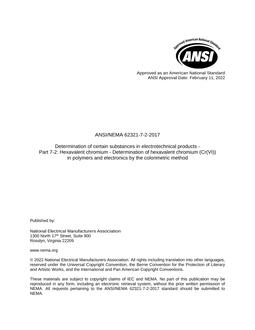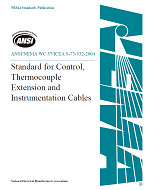
ANSI/NEMA 62321-7-2-2017
This part of IEC 62321 describes procedures to measure hexavalent chromium, Cr(VI), quantitatively in samples of polymers and electronics. This method employs organic solvent to dissolve or swell the sample matrix, followed by an alkaline digestion procedure to extract Cr(VI) from samples. Studies have shown that organic/alkaline solution is more effective than acidic solution in extracting Cr(VI) from soluble and insoluble samples. Minimal reduction of Cr(VI) to Cr(III) or oxidation of Cr(III) to Cr(VI) occurs under alkaline conditions.
For soluble polymers consisting of ABS (Acrylonitrile- butadiene-styrene), PC (Polycarbonate) and PVC (poly(vinyl chloride)), the samples are first dissolved in an appropriate organic solvent and Cr(VI) is then extracted by an alkaline extraction solution.
For insoluble/unknown polymers, or electronic materials that do not contain antimony (Sb), the samples are digested in a toluene/alkaline solution at 150 °C to 160 °C. Then the organic phase in the extracts are separated and discarded; the inorganic phase is retained for Cr(VI) analysis.
The Cr(VI) concentration in the extract is determined by its reaction under acidic conditions with 1,5-diphenylcarbazide. Cr(VI) is reduced to Cr(III) in the reaction with diphenylcarbazide which is oxidized to diphenylcarbazone. The Cr(III) and diphenylcarbazone form a red-violet coloured complex in the reaction. The complex solution is measured quantitatively by a colorimeter or a spectrophotometer at 540 nm.
Product Details
- Published:
- 2023
- Number of Pages:
- 19
- File Size:
- 1 file , 250 KB
- Product Code(s):
- 100998, 100998, 100998
- Note:
- This product is unavailable in Ukraine, Russia, Belarus

